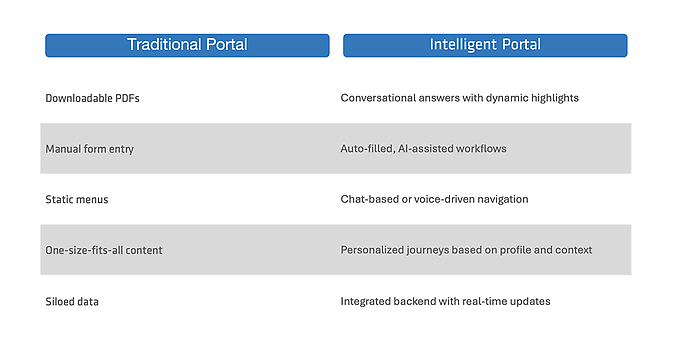18. August 2025 By Matthias Murin and Stefan Raupach
Life Sciences Needs More Than Portals - It Needs Intelligence
In recent years, the life sciences industry has made major strides in digitalization. Patient portals, HCP platforms, and customer service tools have become standard across pharma, biotech, and medtech companies. But despite these efforts, one uncomfortable truth remains: the experience still doesn’t work - not for patients, not for providers, and often not for the business either.
Portals may provide access, but they rarely deliver meaningful interaction. Users are left navigating disconnected systems, static content, and time-consuming processes. The result? Low engagement, rising service costs, and digital solutions that fall short of expectations.
Digital Investments Have Been Made - But the Experience Still Falls Short
Despite years of investment in digital tools and platforms, many life sciences companies - especially in the pharmaceutical, biotech, and medtech sectors - are still grappling with the same systemic challenges:
- Fragmented systems: Healthcare professionals often log into multiple portals just to access basic product data. Patients must switch between separate apps for trial updates, test results, and therapy onboarding.
- Static, one-way portals: Many customer and patient portals function more like document libraries than dynamic interfaces. They offer limited interaction, no personalization, and little automation.
- Manual, repetitive work: Medical teams, service agents, and field reps spend significant time answering common questions, pushing forms, or pulling information from disconnected systems.
- Frustrating user experiences: Whether it’s a clinician searching for safety updates or a patient managing appointments, digital experiences often feel robotic and inefficient.
- High cost-to-serve: With support teams stretched and labor costs rising, each interaction becomes more expensive to deliver.
The result? Underused platforms, low engagement, high attrition - and a digital infrastructure that fails to scale with the business.
Static Portals Are Not the Future - Intelligent Interfaces Are
The expectations of patients, healthcare professionals, and partners have changed. Static content hubs and form-based portals no longer meet the needs of modern engagement. Instead, life sciences organizations must embrace a new generation of digital interaction - one that is conversational, intelligent, and action-oriented.
This is where Conversational AI and Agentic AI come in
These technologies go far beyond simple chatbots. They create intuitive, multimodal experiences - across chat, voice, text, and video - that allow users to ask questions, complete tasks, and receive proactive guidance in real time.
- Conversational AI enables natural interaction by understanding intent, context, and nuance.
- Agentic AI takes this further by autonomously initiating actions, making decisions within defined boundaries, and orchestrating workflows across systems.
Together, they unlock the potential to move from passive portals to intelligent interfaces that deliver measurable value - for users and the business alike.
Fully integrated customer portals
Seamless. Digital. Customer-focused.
With fully integrated customer portals, you can create personalised experiences, increase efficiency and strengthen the trust of your target groups – whether they are patients, medical staff or partners. adesso supports you from strategy to implementation with in-depth industry expertise and modern technologies.
Discover how our services can transform your customer portal
Where AI Delivers Value: Real Use Cases in Life Sciences
Let’s look at how Conversational and Agentic AI are already transforming patient services, clinical research, HCP engagement, and customer support - with measurable results.
1. Patient Services and Support
The Challenge:
Patients often struggle with onboarding, medication adherence, and accessing timely support - especially across multilingual or complex care environments.
Conversational AI:
- Virtual assistants guide patients step by step through onboarding and therapy initiation.
- Smart reminders and nudges support adherence to treatment plans.
- Chat and voice interfaces streamline data collection and follow-up interactions.
Agentic AI:
- AI agents proactively detect signs of disengagement and trigger re-engagement workflows.
- Routine tasks such as case triage, refill scheduling, and care coordination are fully automated.
Tangible Outcomes:
- 60 to 80 % fewer Tier 1 support tickets
- Up to 25 % improvement in adherence and satisfaction
- 35 % lower cost per patient interaction
2. Clinical Trials and Research
The Challenge:
Slow recruitment, high dropout rates, and heavy communication workloads slow down studies and increase costs.
Conversational AI:
- AI agents handle eligibility screening and respond to pre-enrollment questions.
- Participants receive real-time support for patient-reported outcomes (PROs).
- 24/7 availability ensures consistent engagement throughout the trial journey.
Agentic AI:
- Automated detection and documentation of adverse events.
- Predictive analysis identifies dropout risk and initiates proactive retention measures.
Tangible Outcomes:
- 30 to 40 % faster participant recruitment
- 20 to 25 % lower dropout rates
- 50 % reduction in issue resolution time during trials
3. HCP Engagement and Scientific Communication
The Challenge:
Medical affairs and commercial teams struggle to deliver timely, personalized, and compliant engagement at scale.
Conversational AI:
- Medical information is made accessible through chat-based search and voice assistants.
- Field reps get real-time briefing support for pre-call planning and on-the-go insights.
Agentic AI:
- AI agents proactively follow up with HCPs based on behavior and territory insights.
- Documents such as MSL summaries and meeting notes are generated automatically.
Tangible Outcomes:
- 40 to 60 % faster access to scientific content
- Up to 30 % increase in touchpoints per MSL or sales rep
- 25 % higher ROI on digital engagement initiatives
4. Customer Service and Operations
The Challenge:
Service teams are overwhelmed by repetitive inquiries, product questions, and adverse event reporting.
Conversational AI:
- Virtual assistants handle routine product inquiries and guide users through structured workflows (e.g., returns, complaints).
- Real-time integration with Salesforce, Veeva, or SAP ensures up-to-date responses.
Agentic AI:
- Agents resolve end-to-end requests across multiple backend systems.
- Complex cases are automatically escalated with full context and urgency scoring.
Tangible Outcomes:
- 70 to 85 % automation of Tier 1 service requests
- 40 % faster average resolution time
- 30 % cost savings in customer service operations
From Static Portal to Intelligent Action Hub
In many organizations today, portals are still designed as static entry points - repositories for documents or forms. They offer access, but little interaction. As a result, adoption is low and value creation is limited.
But this doesn’t have to be the case. With AI, portals can evolve from passive content platforms into intelligent, responsive ecosystems - ones that support real-time engagement, automate workflows, and deliver measurable outcomes.
Here’s what that shift looks like in practice:

Examples in action:
This shift doesn’t require a complete rebuild. In fact, the most successful transformations begin with small, high-impact enhancements:
- Replacing static interfaces with chat- or voice-enabled agents
- Embedding automation into common workflows
- Connecting portals to backend systems for real-time execution
In short:Move from Login → Search → Download to Login → Ask → Do.
Portals should no longer be just digital destinations - they should become intelligent surfaces for action, conversation, and value creation.
From Pilots to Scalable Impact: Building AI Maturity in Life Sciences
Many organizations start their AI journey with isolated pilots - a chatbot here, an automation there. But to truly unlock the value of Conversational and Agentic AI, life sciences companies need a clear path toward scalable, integrated use.
That’s why we developed the adesso AI Maturity Assessment: a structured approach to help life sciences organizations evaluate where they stand - and where to go next.
We typically see four levels of maturity:
1. Automation Ready
What it looks like: Rule-based bots and scripted workflows
ROI potential: ~20 % efficiency gains in routine interactions
2. Integrated AI Assistants
What it looks like: Connected to backend systems like CRM, ERP, or Veeva; contextualized responses
ROI potential: 30 to 40 % improvement in support and service operations
3. Proactive Intelligence
What it looks like: Predictive nudging, real-time recommendations, behavior-based engagement
ROI potential: Up to 50 % boost in digital engagement and patient adherence
4. Agentic Ecosystems
What it looks like: Multi-agent coordination, decision-making within defined constraints, orchestration across platforms
ROI potential: Up to 70 % cost reduction in repetitive tasks, exponential user experience gains
Don’t Just Modernize - Leap Ahead
Conversational and Agentic AI are more than operational upgrades. They are strategic levers to redesign how life sciences companies engage with every stakeholder - patients, providers, and partners.
Early adopters will not only reduce costs, but also:
- Unlock new sources of revenue
- Strengthen relationships across the value chain
- Position themselves as leaders in intelligent health ecosystems
Take the next step – we're here to support you!
Let us make your AI transformation real, measurable and scalable. Contact us to receive a customised AI maturity analysis or arrange a discovery workshop.


